Unit 3 Topic 2 Section B课件+内嵌音视频(仁爱科普版九年级上册)
文档属性
| 名称 | Unit 3 Topic 2 Section B课件+内嵌音视频(仁爱科普版九年级上册) | 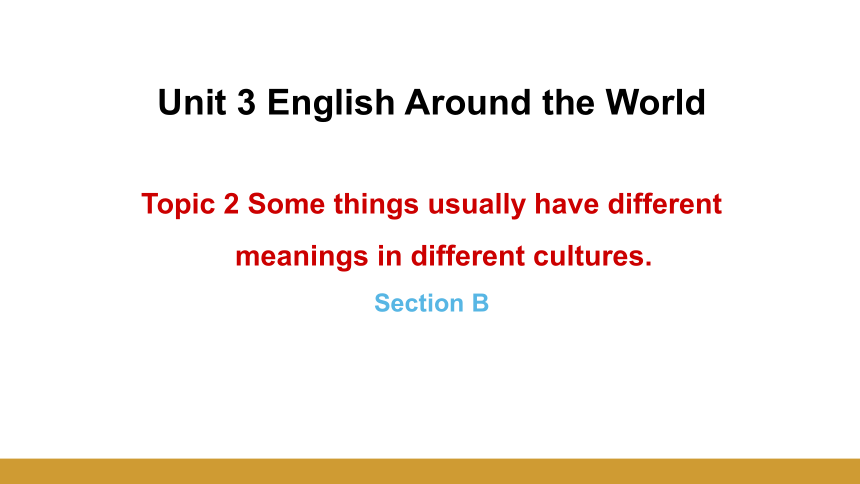 | |
| 格式 | pptx | ||
| 文件大小 | 50.3MB | ||
| 资源类型 | 试卷 | ||
| 版本资源 | 仁爱科普版 | ||
| 科目 | 英语 | ||
| 更新时间 | 2023-06-30 10:44:16 | ||
图片预览

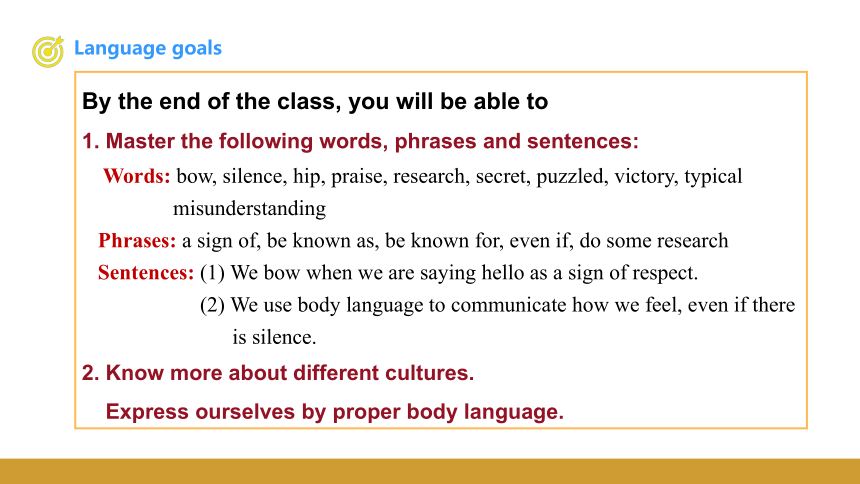

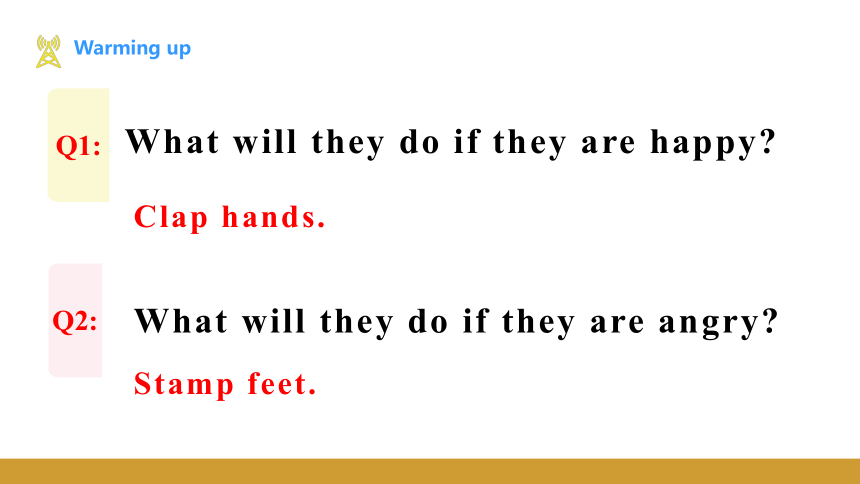
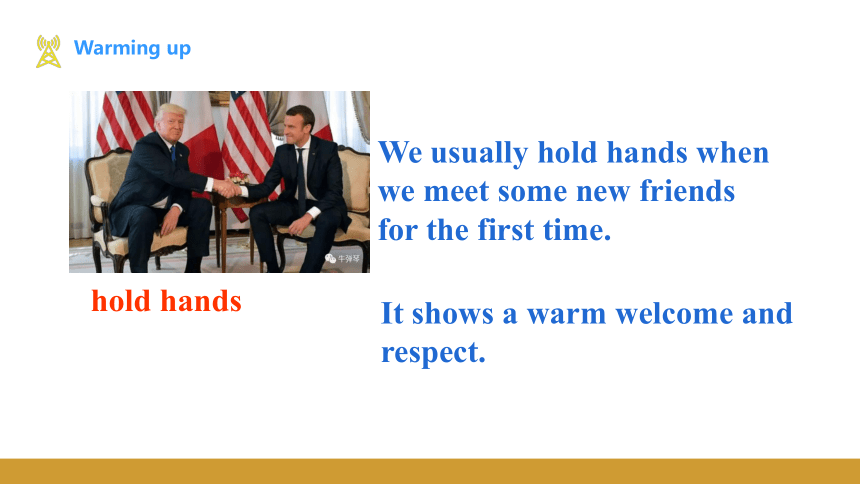

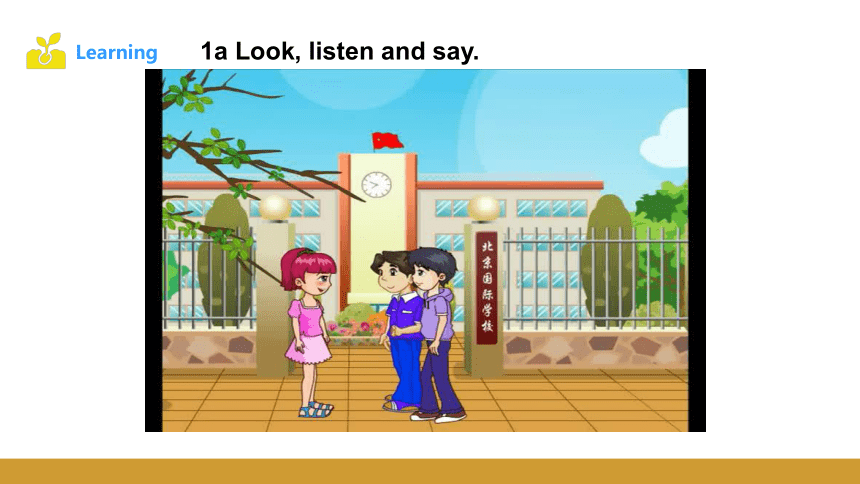
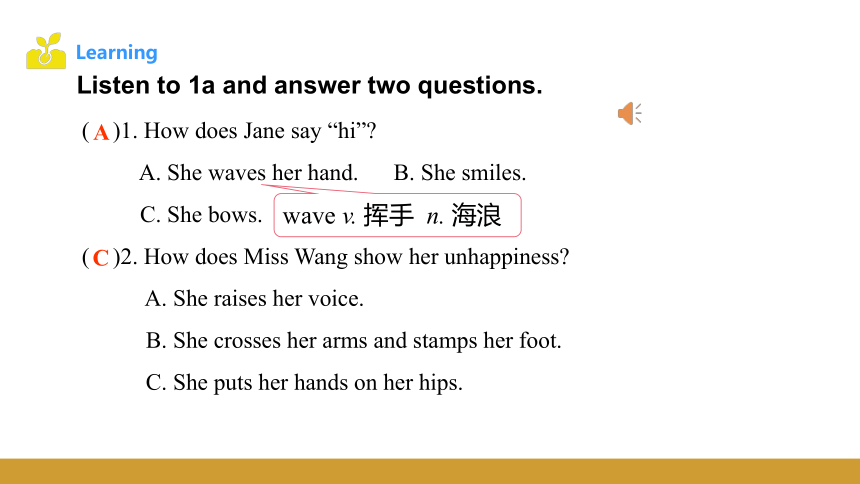
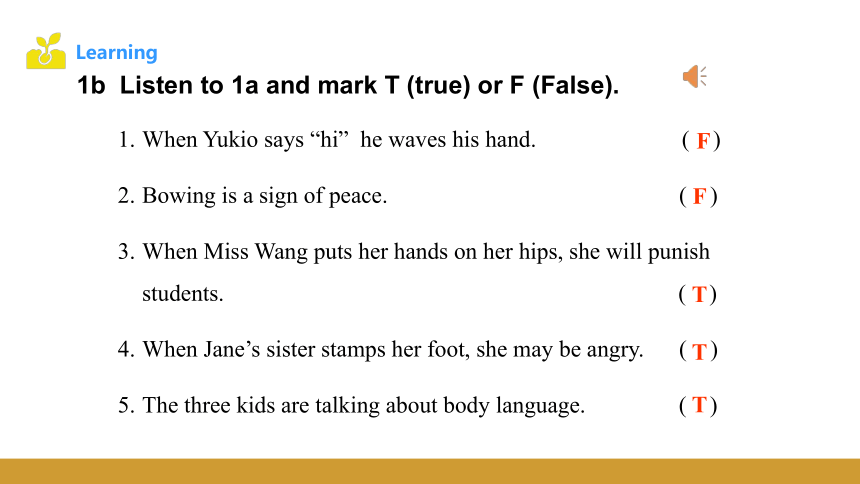
文档简介
(共21张PPT)
Unit 3 English Around the World
Topic 2 Some things usually have different meanings in different cultures.
Section B
By the end of the class, you will be able to
1. Master the following words, phrases and sentences:
Words: bow, silence, hip, praise, research, secret, puzzled, victory, typical
misunderstanding
Phrases: a sign of, be known as, be known for, even if, do some research
Sentences: (1) We bow when we are saying hello as a sign of respect.
(2) We use body language to communicate how we feel, even if there
is silence.
2. Know more about different cultures.
Express ourselves by proper body language.
Watch the video.
What will they do if they are happy
Clap hands.
What will they do if they are angry
Stamp feet.
Q1:
Q2:
hold hands
We usually hold hands when we meet some new friends for the first time.
It shows a warm welcome and respect.
stamp one’s foot
What does the body language show
It shows one’s anger.
It is a typical sign of showing one’s anger.
adj. 典型的,有代表性的
1a Look, listen and say.
( )1. How does Jane say “hi”
A. She waves her hand. B. She smiles.
C. She bows.
( )2. How does Miss Wang show her unhappiness
A. She raises her voice.
B. She crosses her arms and stamps her foot.
C. She puts her hands on her hips.
A
C
Listen to 1a and answer two questions.
wave v. 挥手 n. 海浪
When Yukio says “hi” he waves his hand. ( )
Bowing is a sign of peace. ( )
When Miss Wang puts her hands on her hips, she will punish students. ( )
When Jane’s sister stamps her foot, she may be angry. ( )
The three kids are talking about body language. ( )
F
F
T
T
T
1b Listen to 1a and mark T (true) or F (False).
Waving and bowing are examples of _______ language. In Japan, people bow as a sign of __________. In Canada, people wave as a sign of _________ and ____________. In all cultures, people smile when they are _______. Body language can mean different things in different ________________. If we understood body language from different countries, we could _____________ better.
friendship
body
happy
peace
cultures/countries
communicate
respect
1c Read 1a and fill in the blanks.
1. I think that is known as body language.
我觉得这就是肢体语言。
be known for
be known as
be known to sb.
be famous for
=
=
be famous as
作为……而出名
因为……而出名
被某人所……熟知
(1)重庆因为火锅而出名。
Chongqing ___________________ hot pot.
(2)重庆作为山城出名。
Chongqing ____________________ a mountain city.
is known/famous as
is known/famous for
e.g.
2. We use body language to communicate how we feel, even if there is
silence. 我们用肢体语言表达我们的感受,即使是沉默的时候。
even if= even though 意为“即使、纵然”, 引导让步状语从句
即使她回家很晚,她每晚也要给母亲打电话。
e.g. Even if she returns home quite late, she calls her mother
every night.
do some research (on) 做关于……的研究
Jane 最近在做一些关于英式英语和美式英语差异的研究。
e.g. Recently Jane __________________________ the differences
between British English and American English.
has done some research on
3. We should do some research. 我们应该做些研究。
Work in pairs and practice the dialog.
Kangkang: When Jane says “Hi” she __________, but when you say “Hello” you ____.
Yukio: In Japan, we bow when we are saying hello _________.
Jane: In Canada, we wave as _________.
Kangkang: I think that ________ body language. We use body language to __________, even if _________.
Yukio: Did you notice that Miss Wang smiles ____, and when she is angry ________ Then I know whether she will praise or punish us.
Jane: (Laughing) When my little sister is angry, she __________!
Kangkang: I wonder if body language means _____.
Jane: We should _______. People could _________ if they _____.
Yukio: Let’s ask Miss Wang and Ms. Jones if they will ______
a
e
d
c
b
f
___ Good luck.
___ I’m puzzled.
___ I’m just kidding.
___ It’s a secret.
___ Calm down.
___ Have a victory.
a
b
d
c
f
2a Look at these gestures that are common in the USA. Discuss and match each gesture with its meaning below.
e
2b Do you know any other gestures In groups, act them out
and guess what they mean.
Put these sentences in the correct order to form a passage.
( ) Body language means different things in different cultures.
( ) In Canada, nodding your head shows agreement.
( ) But people shake their heads from side to side to show agreement in India.
( ) So, to avoid misunderstanding, you should study both spoken and body
languages.
( ) However, in India, men often hold hands a sign of friendship.
( ) North American men seldom hold hands in public.
( ) For example, the signs of showing agreement and friendship are different
from culture to culture.
4
1
6
7
3
5
2
4 Discuss the typical body language your teachers/classmates often use with the following questions. Then report to the whole class, pay attention to the pause, liasion and intonation.
I. Choose the best answer.
( ) 1. Yang Liwei, the national hero is known ____ all the Chinese.
A. for B. as C. to D. with
( ) 2. —Hi, Jane, tell you a piece of good news. I ____ America tomorrow.
—Wow, have a good trip!
A. am leaving for B. leaves for
C. have left for D. left for
( ) 3. _____ she has failed for several times, she never gives up.
A. If B. Because C. Even if D. As if
( ) 4. —I’m going to have an exam tomorrow. —________
A. Calm down. B. Good luck.
C. You’re kidding. D. I’m puzzled.
C
A
B
C
5. Stamping her foot is my sister’s ________ (典型的)gesture.
6. Shaking hands is ____________(……的标志)friendship in most of
the countries.
7. They are busy _____________________(做关于……的研究)how to
improve the environment.
8. Miss Wang usually raises her thumbs to _______ (表扬) us.
typical
a sign of
doing some research on
praise
II. Fill in the blanks.
Some words: bow, silence, hip, praise, research, secret, puzzled, victory, typical, misunderstanding
2. Some phrases: a sign of, be known as, be known for, even if, do some research
3. Some sentences:
(1) We bow when we are saying hello as a sign of respect.
(2) We use body language to communicate how we feel, even if there is silence.
(1) Know more about different cultures.
(2) Express ourselves by proper body language.
We learn:
We can:
Read 1a.
Memorize the useful expressions and key sentences which we learnt today.
Finish Section B in your workbook.
Preview Section C.
Unit 3 English Around the World
Topic 2 Some things usually have different meanings in different cultures.
Section B
By the end of the class, you will be able to
1. Master the following words, phrases and sentences:
Words: bow, silence, hip, praise, research, secret, puzzled, victory, typical
misunderstanding
Phrases: a sign of, be known as, be known for, even if, do some research
Sentences: (1) We bow when we are saying hello as a sign of respect.
(2) We use body language to communicate how we feel, even if there
is silence.
2. Know more about different cultures.
Express ourselves by proper body language.
Watch the video.
What will they do if they are happy
Clap hands.
What will they do if they are angry
Stamp feet.
Q1:
Q2:
hold hands
We usually hold hands when we meet some new friends for the first time.
It shows a warm welcome and respect.
stamp one’s foot
What does the body language show
It shows one’s anger.
It is a typical sign of showing one’s anger.
adj. 典型的,有代表性的
1a Look, listen and say.
( )1. How does Jane say “hi”
A. She waves her hand. B. She smiles.
C. She bows.
( )2. How does Miss Wang show her unhappiness
A. She raises her voice.
B. She crosses her arms and stamps her foot.
C. She puts her hands on her hips.
A
C
Listen to 1a and answer two questions.
wave v. 挥手 n. 海浪
When Yukio says “hi” he waves his hand. ( )
Bowing is a sign of peace. ( )
When Miss Wang puts her hands on her hips, she will punish students. ( )
When Jane’s sister stamps her foot, she may be angry. ( )
The three kids are talking about body language. ( )
F
F
T
T
T
1b Listen to 1a and mark T (true) or F (False).
Waving and bowing are examples of _______ language. In Japan, people bow as a sign of __________. In Canada, people wave as a sign of _________ and ____________. In all cultures, people smile when they are _______. Body language can mean different things in different ________________. If we understood body language from different countries, we could _____________ better.
friendship
body
happy
peace
cultures/countries
communicate
respect
1c Read 1a and fill in the blanks.
1. I think that is known as body language.
我觉得这就是肢体语言。
be known for
be known as
be known to sb.
be famous for
=
=
be famous as
作为……而出名
因为……而出名
被某人所……熟知
(1)重庆因为火锅而出名。
Chongqing ___________________ hot pot.
(2)重庆作为山城出名。
Chongqing ____________________ a mountain city.
is known/famous as
is known/famous for
e.g.
2. We use body language to communicate how we feel, even if there is
silence. 我们用肢体语言表达我们的感受,即使是沉默的时候。
even if= even though 意为“即使、纵然”, 引导让步状语从句
即使她回家很晚,她每晚也要给母亲打电话。
e.g. Even if she returns home quite late, she calls her mother
every night.
do some research (on) 做关于……的研究
Jane 最近在做一些关于英式英语和美式英语差异的研究。
e.g. Recently Jane __________________________ the differences
between British English and American English.
has done some research on
3. We should do some research. 我们应该做些研究。
Work in pairs and practice the dialog.
Kangkang: When Jane says “Hi” she __________, but when you say “Hello” you ____.
Yukio: In Japan, we bow when we are saying hello _________.
Jane: In Canada, we wave as _________.
Kangkang: I think that ________ body language. We use body language to __________, even if _________.
Yukio: Did you notice that Miss Wang smiles ____, and when she is angry ________ Then I know whether she will praise or punish us.
Jane: (Laughing) When my little sister is angry, she __________!
Kangkang: I wonder if body language means _____.
Jane: We should _______. People could _________ if they _____.
Yukio: Let’s ask Miss Wang and Ms. Jones if they will ______
a
e
d
c
b
f
___ Good luck.
___ I’m puzzled.
___ I’m just kidding.
___ It’s a secret.
___ Calm down.
___ Have a victory.
a
b
d
c
f
2a Look at these gestures that are common in the USA. Discuss and match each gesture with its meaning below.
e
2b Do you know any other gestures In groups, act them out
and guess what they mean.
Put these sentences in the correct order to form a passage.
( ) Body language means different things in different cultures.
( ) In Canada, nodding your head shows agreement.
( ) But people shake their heads from side to side to show agreement in India.
( ) So, to avoid misunderstanding, you should study both spoken and body
languages.
( ) However, in India, men often hold hands a sign of friendship.
( ) North American men seldom hold hands in public.
( ) For example, the signs of showing agreement and friendship are different
from culture to culture.
4
1
6
7
3
5
2
4 Discuss the typical body language your teachers/classmates often use with the following questions. Then report to the whole class, pay attention to the pause, liasion and intonation.
I. Choose the best answer.
( ) 1. Yang Liwei, the national hero is known ____ all the Chinese.
A. for B. as C. to D. with
( ) 2. —Hi, Jane, tell you a piece of good news. I ____ America tomorrow.
—Wow, have a good trip!
A. am leaving for B. leaves for
C. have left for D. left for
( ) 3. _____ she has failed for several times, she never gives up.
A. If B. Because C. Even if D. As if
( ) 4. —I’m going to have an exam tomorrow. —________
A. Calm down. B. Good luck.
C. You’re kidding. D. I’m puzzled.
C
A
B
C
5. Stamping her foot is my sister’s ________ (典型的)gesture.
6. Shaking hands is ____________(……的标志)friendship in most of
the countries.
7. They are busy _____________________(做关于……的研究)how to
improve the environment.
8. Miss Wang usually raises her thumbs to _______ (表扬) us.
typical
a sign of
doing some research on
praise
II. Fill in the blanks.
Some words: bow, silence, hip, praise, research, secret, puzzled, victory, typical, misunderstanding
2. Some phrases: a sign of, be known as, be known for, even if, do some research
3. Some sentences:
(1) We bow when we are saying hello as a sign of respect.
(2) We use body language to communicate how we feel, even if there is silence.
(1) Know more about different cultures.
(2) Express ourselves by proper body language.
We learn:
We can:
Read 1a.
Memorize the useful expressions and key sentences which we learnt today.
Finish Section B in your workbook.
Preview Section C.
同课章节目录
- Unit 1 The Changing World
- Topic 1 Our country has developed rapidly.
- Topic 2 The population in developing countries is
- Topic 3 The world has changed for the better.
- Unit 2 Saving the earth.
- Topic 1 Pollution has causes too many problems.
- Topic 2 All these problems are very serious.
- Topic 3 What can we do to protect the environment
- Unit 3 English around the World
- Topic 1 English is widely spoken around the world.
- Topic 2 Some things usually have different meaning
- Topic 3 Could you give us some advice on how to l
- Unit 4 Amazing Science
- Topic 1 When was it invented?
- Topic 2 I'm excited about the things that will be
- Topic 3 China is the third nation that sent a pers
